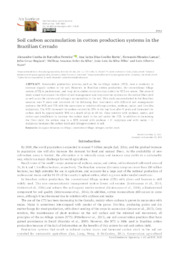Soil carbon accumulation in cotton production systems in the Brazilian Cerrado.
Soil carbon accumulation in cotton production systems in the Brazilian Cerrado.
Author(s): FERREIRA, A. C. de B.; BORIN, A. L. D. C.; LAMAS, F. M.; BOGIANI, J. C.; SILVA, M. A. S. da; SILVA FILHO, J. L. da; STAUT, L. A.
Summary: Sustainable production systems, such as the no-tillage system (NTS), have a tendency to increase organic carbon in the soil. However, in Brazilian cotton production, the conventional tillage system (CTS) is predominant, and long-term studies on cotton crop under the NTS are scarce. The present study aimed to evaluate the effect of soil management and crop rotation systems on the cotton fiber yield as well as on the carbon and nitrogen accumulation in the soil. This study was conducted in the Brazilian savanna over 9 years and consisted of the following four treatments with different soil management systems: the NTS and CTS with the succession or rotation of crops (cotton, soybean, maize, and Urochloa ruziziensis). The NTS increased the carbon content by 55% in the top 5 cm after 9 years and increased the carbon stock by approximately 20% at a depth of up to 40 cm. Crop rotation with soybean, maize, and cotton was insufficient to increase the carbon stock in the soil under the CTS. In addition to increasing the fiber yield, the cotton crop in a NTS rotated with soybean + U. ruziziensis and with maize + U. ruziziensis increases the carbon stock and nitrogen content in soil.
Publication year: 2020
Types of publication: Journal article
Unit: Embrapa Cotton
Keywords: Algodão, Carbon stock, Carbono, Cerrado, Conventional tillage, Estoque, Gossypium Hirsutum, Nitrogen, Nitrogênio, No-tillage, Plantio Direto
Observation
Some of Embrapa's publications are published as ePub files. To read them, use or download one of the following free software options to your computer or mobile device. Android: Google Play Books; IOS: iBooks; Windows and Linux: Calibre.
Access other publications
Access the Agricultural Research Database (BDPA) to consult Embrapa's full library collection and records.
Visit Embrapa Bookstore to purchase books and other publications sold by Embrapa.

